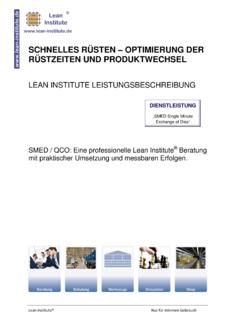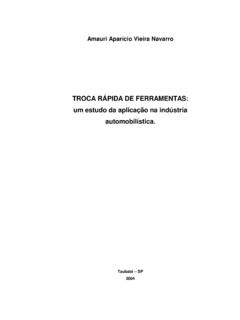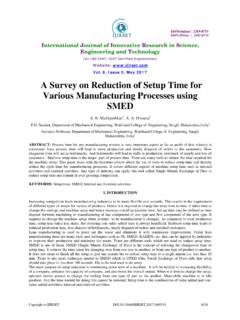Transcription of Reducing Machine Setup & Changeover Times
1 Reducing Machine Setup & Changeover Times Learn how to gain valuable manufacturing capacity in a very short time, applying creativity and common sense before capital. By Charles F. Keberdle, CPIM Copyright 2008 All rights reserved Lean Solutions Group 30996 Walden Drive Westlake, OH 44145 440-666-7767 web: Reducing Machine Setup Times in Any Manufacturing Setting The main goal of set up reduction is to reduce Machine down time. Reducing Setup time will boost your company s capacity, increase your manufacturing flexibility, and help increase overall output. A simple saying I often use is, If the Machine is not running, you are not making money . Grammatically this sentence may not be correct, but the message is absolutely right. While your operators or technicians are scurrying around to change tooling from one job to the next, that Machine or assembly operation is idle.
2 And the time that is passing by cannot be stored or be recovered for future use. So why focus on Setup Times ? Most likely your customers will continue to demand new features, options, and customized applications of your products. It is impractical, unwise, and maybe impossible to attempt to make and hold these various products in inventory. Lot sizes will also decrease because your customers are also managing their businesses more efficiently. So the increasing proliferation of product features and options translates into more job changes/setups, and that leads to more lost production time between jobs. Here are some tips and a proven methodology your organization can apply to reduce Setup time between jobs. What is Setup time? Setup time refers to the total elapsed time realized for changing a piece of equipment over from making the last part of a production batch to making the first good part of the following production batch.
3 Why not simply increase the speed of your machinery or ask people to work faster? Think about the differences between Setup and run Times . Run time is the amount of time required to process or assemble each unit. Run time is adding value, transforming materials into what your customers require and are willing to purchase. Are your customers willing to pay for excessive amounts of Setup time while your machinery is being prepared to produce their products? Speeding up the run time of the machines will help reduce lead Times . But shortening Setup Times and making them more consistent your organization s manufacturing costs will decrease while its flexibility to meet customer demands will expand. For an example, picture a NASCAR race team s pit crew changing a set of tires, refueling a vehicle, cleaning the windshield, and giving the driver some a refreshing drink in seconds.
4 Do they wait until the car stops before getting the new tires or jack? No! The crew has practiced their jobs relentlessly, knowing not only their roles, but everyone else s as well. There are manufacturing companies capable of changing a die set, weighing thousands of pounds, in single-minutes. Yet many manufacturers fall far outside either of these two examples in terms of setting record Times for changing their equipment s tooling between jobs. Why? They have not embraced SMED. What is SMED? Single minute exchange of die (SMED) is a concept originated by Dr. Shigeo Shingo, a Japanese thought leader who helped evolve the Toyota Production System. Dr. Shingo is considered the world's leading expert on improving the manufacturing process and he was also popularly known as "Dr. Improvement" in Japan. The SMED system is a simple yet powerful process. Dr. Shingo s main prerequisite is to use Scientific Thinking.
5 By this term he means that one needs keep an open mind and personally watch a process to learn what is happening. Let us take a look at a simple, single-stage Machine Setup example. Lean Solutions Group 30996 Walden Drive Westlake, OH 44145 440-666-7767 web: (Graphical example that illustrates the impacts of Setup reduction). What are typical Setup steps? Basic steps in a Setup process: Preparation, gathering tools, materials etc o Searching for misplaced/lost tools, waiting for tooling, obtaining process instructions, etc. Exchanging, removing old parts/tools, etc. o Removal of previous tooling and mounting/placement of next job s tooling Positioning, repositioning, settings, and calibration o Loosening and tightening fasteners for tooling, loading materials into position o Calibrating tooling, establishing initial control settings Gauging, trial runs, and making adjustments o This category typically makes up the majority of Setup time due to re-calibrations, missing or broken tooling/fixtures, incorrect materials being used o Additional measurements of parts until settings are correct What are the benefits of Reducing Setup Times ?
6 Shorter lead time and increased capacity Capital equipment purchases avoided or delayed Better quality/more-consistent processes Lower manufacturing costs and improved cash flow Less inventory Increased flexibility Better workforce utilization Less process variability Impact of Setup ReductionImpact of Setup ReductionTeardownPreparation(Internal)Se tup Part#2 TeardownSetupPart#2 Changeover TimeSetup ReductionChangeover TimeBeforeAfterComplete MachiningPart #1 Complete MachiningPart #1 Begin MachiningPart #2 Begin MachiningPart #2 Preparation(External) Lean Solutions Group 30996 Walden Drive Westlake, OH 44145 440-666-7767 web: What are the key steps for Reducing Setup Times ? 1. Begin with management s support and commitment a. Without their approval and clear sanctioning, of lean manufacturing tools, success will be difficult to sustain 2.
7 Identify and select a process improvement team consisting of your best Setup / Machine operators that are able to identify and separate internal and external steps a. Start with your current state --- select and focus on one Machine b. Walk-through the entire Setup process, in detail, and record the steps in written or video format c. Identify detailed internal Setup steps as these require the Machine to stop i. Example: Removing a die from a press d. Identify detailed external steps --- steps that may be performed as the Machine is running i. Example: Obtaining the die required for the next job while the current job is in progress e. Separate the work while the Machine is stopped in order to categorize each activity as either internal or external 3. Convert internal steps to external steps a. What external steps of your Setup process are you treating as internal steps?
8 Example: Plan every day and communicate which machines will require setups, and calculate approximately when they will take place b. Prepare dies, tooling, and materials outside of the department while the current job is still running 4. Reduce remaining Internal Work a. Work with Machine operators and Setup people to better understand what their challenges are---remove these barriers so they focus more on fast changeovers rather than performing non-valued added tasks 5. Create improved Setup / Changeover process a. Capture and analyze accurate Setup data, then focus on the steps wasting the most time b. Ask operators for their thoughts---they are closest to the process! i. Train all operators/ Setup people in the new process c. Clearly label, organize, store, and maintain all tooling to minimize surprises d. Use dowels or go-no go fastening systems to eliminate adjustments in the first place, ensure tooling is cleaned and maintained as it is returned to its stocking location after previous use.
9 6. Ultimate goal: abolish Setup a. This may be a lofty goal, but consider: i. Group Technology Analysis (GTA)---study and match your customer s requirements with your production capabilities, simplify product design and procurement, and other processes ii. Combine subsequent jobs with common setups, if inventory implications are not created Other suggestions to reduce Setup time 1. Improved production planning/job sequencing, taking advantage of combined setups, for example a. Create a predecessor/successor matrix, based on product/ Machine i. Example: Paint manufacturers may produce in lightest to darkest color order b. Group Technology Analysis, using work cells where possible 2. Design and product standardization 3. Work standardization, simplification, and operator involvement in optimization process 4. Mechanization or automation 5. Employing technology to capture accurate Setup data that helps you understand current processes For more information about rapidly Reducing Setup Times and improving your profitability please contact: Lean Solutions Group 30996 Walden Drive Westlake, OH 44145 Phone: (440)-666-7787 Copyright - 2008 All rights reserved.
10




